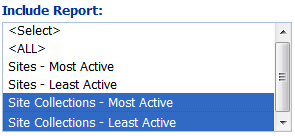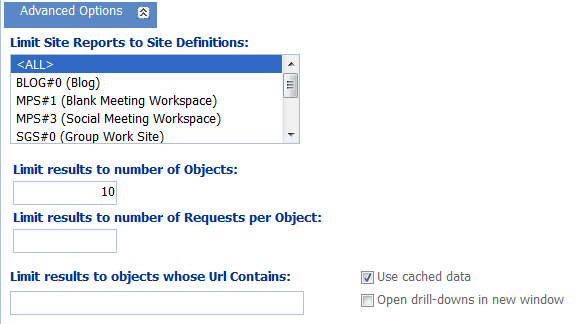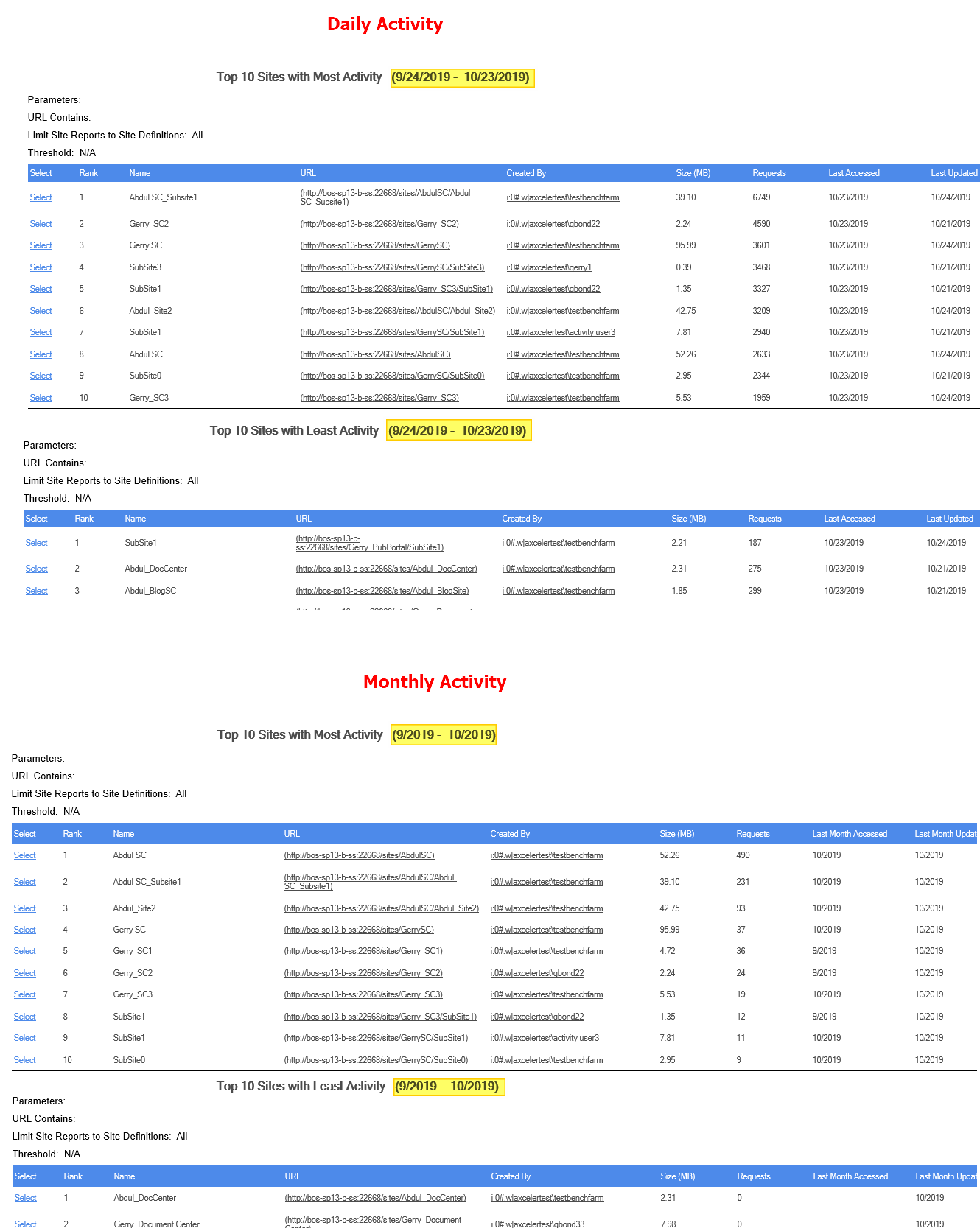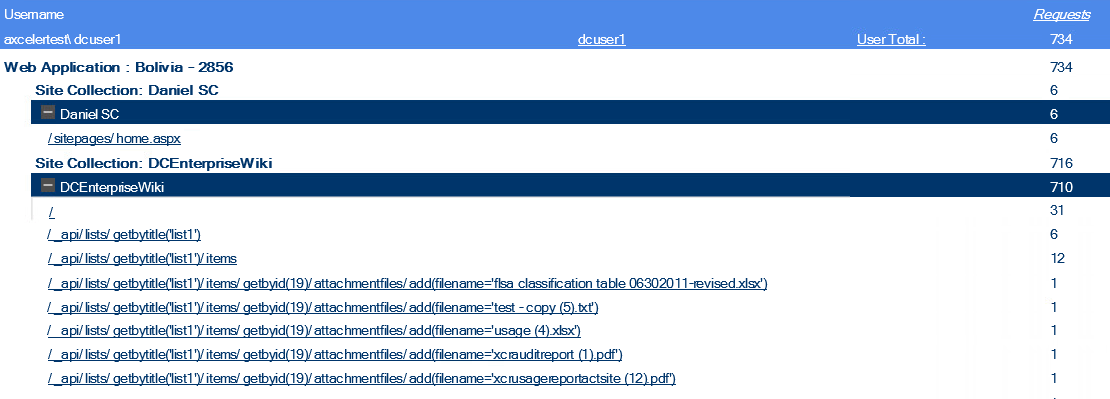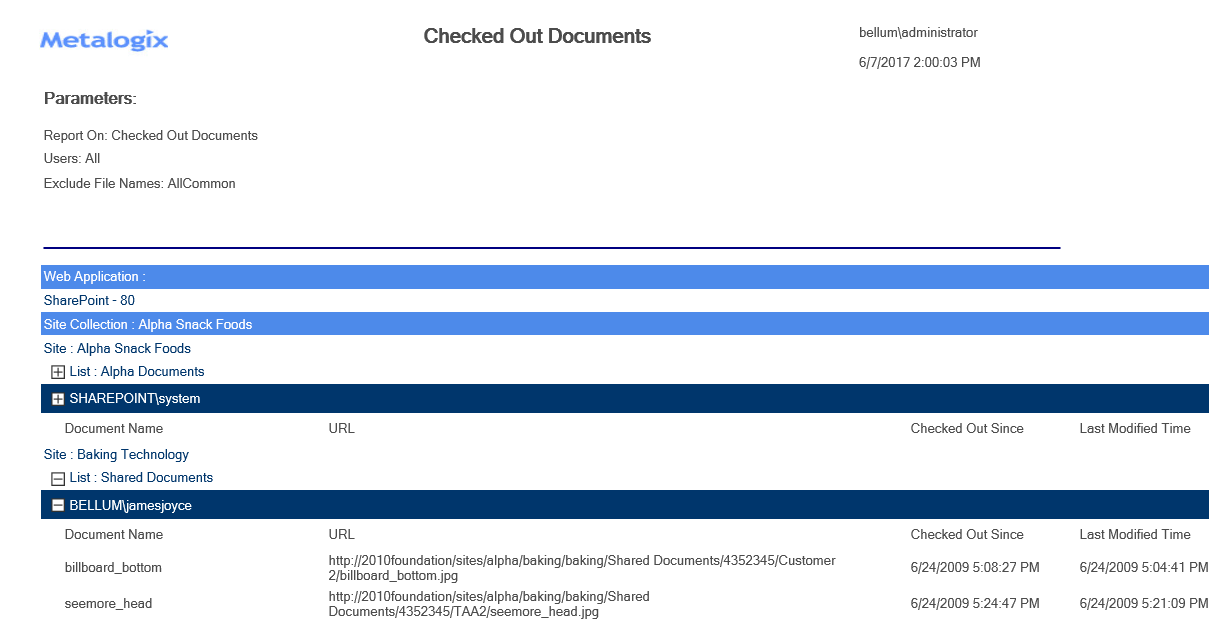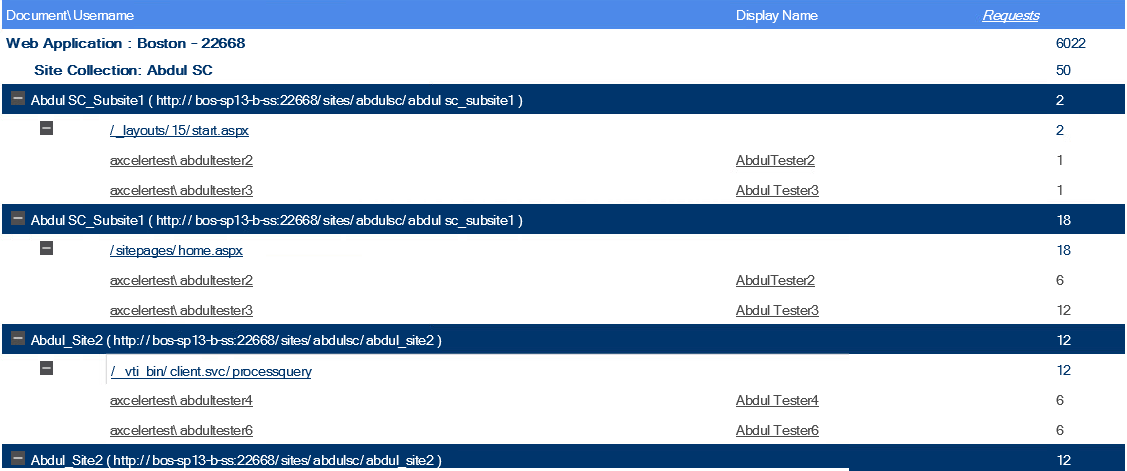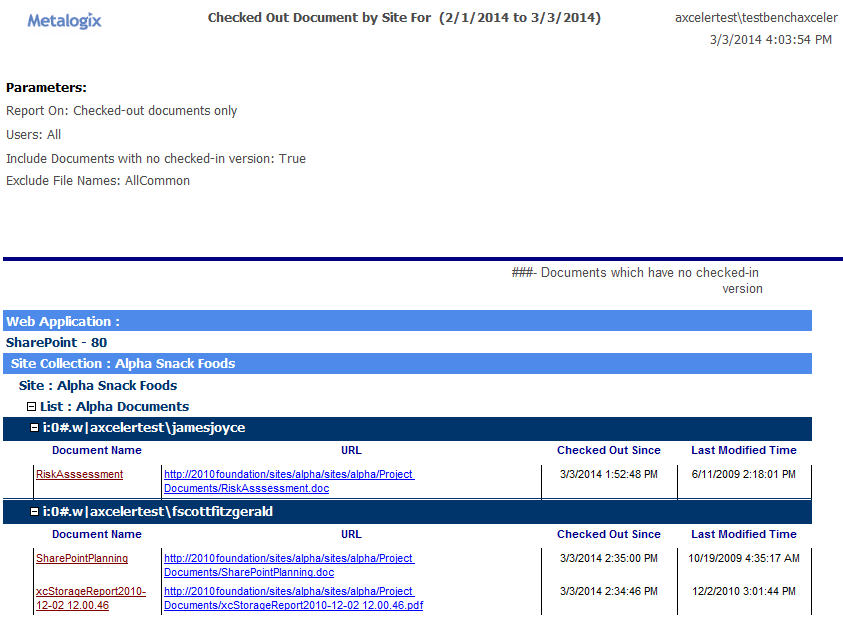Analyzing Most/Least Activity
Use the ControlPoint Most/Least Activity analysis to examine SharePoint objects within a selected scope and specific date range, ranked according to:
·most or least active site collections and/or sites
·most or least active lists, list items, users, and/or pages.
You can further narrow your result set to include only objects that meet specific criteria and/or thresholds.
NOTE: The SharePoint Search Service is used to collect monthly data (up to 36 months by default but may vary depending on how the Search Service is configured).
To generate a Most/Least Activity analysis:
1Select the object(s) for which you want to analyze most/least activity.
2Choose Activity > Most/Least Activity.
3Specify the following parameters for your analysis:
a)Select the object types you want to analyze:
§Site Collections and Sites
OR
§Documents, Pages, and Users.
Note that remaining parameters are populated based on the object type selected.
b)If you selected Site Collections and Sites, Select either Show Daily Activity or Show Cumulative Monthly Activity
NOTE: If you selected Documents, Pages, and Users, you can only analyze daily activity and this option is unavailable.
c)From the Include Report list box, select the type(s) of activity that you want to include in your analysis.
NOTE: If you choose multiple types of activity, each result set will be displayed in a separate subsection.
d)If you want results to cover a time period different than the default date range (for Daily, the past 30 days; for Monthly, from the beginning of the past month up to the current day of the current month), specify a different Start Date and/or End Date.
4If you want to further refine your results, expand the Advanced Options panel.
a)If you want to limit your result set to objects that meet one or more specific criteria, use the information in the following table for guidance.
|
If you want to limit each results set... |
Then ... |
|---|---|
|
to objects with one or more specific site definitions (templates) |
select from the Limit Site Reports to Site Definitions list. |
|
to more or less than 10 objects |
change the Limit results to number of Objects default value. NOTE: If this field is blank, the default value (10 objects) will be used. |
|
based on number of requests* |
enter a number for Number of Requests per Object. |
|
to objects whose url contains a specified text string |
enter that string in the Limit results to objects whose URL field. NOTE: If your analysis includes multiple activity types, this limit will apply to each individual result set. |
|
For Documents, Pages, and Users: | |
|
to lists of one or more specific list definitions |
select from the List Definitions list. |
|
to exclude lists that do not display in the site's View all Site Content page |
check the Omit Hidden Lists box. NOTE: If you choose to include hidden lists in analysis results, they are flagged in analysis results with a plus sign (+). |
|
based on number of items in a list* |
enter a number for Limit results to number of List Items per List. |
* NOTE: If your analysis includes "most" activity, results will include objects at or above that limit; for "least" activity, results will include objects at or below that limit.
b)If your analysis includes site collections, you have chosen to show Daily Activity, and you want to use usage data collected directly from SharePoint rather than the ControlPoint cache, uncheck the Use cached data box.
NOTE: Using cached data can significantly reduce the time it takes to generate an analysis on large site collections. Activity at other levels of the hierarchy is always performed in real-time.
Now you can:
·run the operation immediately (by clicking the [Run Now] button)
OR
·schedule the operation to run at a later time or on a recurring basis.
OR
·save the operation as XML Instructions that can be run at a later time.
The body of the analysis includes a subsection for each usage type.
NOTE: For Daily activity, the Last Accessed date shows the last day the site was accessed within the date range covered by the analysis. For Monthly activity, the Last Accessed date shows the last month the site was accessedas far back as the earliest month in the SharePoint Search Services databaseregardless of the date range covered by the analysis.
Site Collections, Sites, or Users with No Activity
Note that if the number of site collections, sites, or users with no activity exceeds the value you specified for Limit Display to, a single line item with the total number with no activity will be returned rather than individual line items.
EXCEPTION: If your analysis includes Site Collections -Least Active and is run using cached (not realtime) data, results will show only site collections with the least amount of actual activity (site collections with no activity will not be included).
TIP: If you want to see all of the site collections, sites or users with no activity, generate another analysis with Limit Display to set to the number shown as the Inactive Count.
Analyzing Activity by User
The Activity by User analysis lets you examine SharePoint pages and documents requested by one or more users.
You can analyze activity over the past 30 days.
You can also use this analysis to identify only files that are currently checked out.
Note About "Common" File Names
Lists of "common file names" and "common file extensions" are maintained in XML file ActivityByUserOrDoc_ExcludedFileNames_2010.xml located on the Web front-end server where ControlPoint is installed, in the following SharePoint hive subdirectory: \TEMPLATE\LAYOUTS\Axceler\App_Data.
The purpose of this list is to give you the option of either including or excluding frequently used files from analysis results. You can customize the XML files to include file names specific to your environment. For example, you may want to filter out image files used on many pages that do not reflect actual patterns of user activity. You can also remove any of the default file names provided by Metalogix.
NOTE: Names in this file will populate the Exclude File Names parameter. By default, this file includes SharePoint internal files. When you specify the parameters for your analysis, you can exclude some or all of the file names in this list.
IMPORTANT: Changes that you make to these files must be copied to any additional Web front-end servers in your farm. Also, whenever you install a ControlPoint update or patch, these files are overwritten with files containing the default lists. Therefore, if you choose to make modifications, it is recommended that you keep a backup of the file in a different location so that you can replace the default version after an update or patch.
To generate an Activity by User analysis:
1Select the object(s) on which you want to perform the analysis.
2Choose Activity > Activity by User.
3Specify the parameters for your analysis.
In addition to "standard" parameters (and the ability to exclude files, as described above), you can choose to have analysis results display information about Checked-out documents only. Results will include documents that were checked out between the specified start and end date, but have not been checked back in as of the analysis run date. If you select this option and also check Include Documents with no checked-in version, only documents that have never been checked in (which may happen, for example, if a document was uploaded but a value was not provided for a required property).
NOTE: If you accept the default (All Activity), the Include Documents with no checked-in version checkbox will always be ignored.
Now you can:
·run the operation immediately (by clicking the [Run Now] button)
OR
·schedule the operation to run at a later time or on a recurring basis.
OR
·save the operation as XML Instructions that can be run at a later time.
|
If you chose to analyze... |
Then ... |
|---|---|
|
All Activity |
The top level of the analysis displays the following information for each user: ·username (login name) and Display Name ·for each Web application: the cumulative number of Page Views for all selected site collections within the Web application (as determined by the scope of your selection) ·for each site collection: the cumulative number of user Requests/Page Views for all of the sites within the site collection ·for each site: the total number of user Requests/page views for pages and documents within the site, and ·the total number of requests/page views made by the user. When a site is expanded, a list of all of the documents and pages that the user requested/viewed displays, along with the following information: ·the relative url for each page or document, and ·the number of requests by the user for each page or document. |
|
Checked-out documents only |
Analysis results display the following information for each checked out document: ·the Document Name (with a link to the ControlPoint Audit Log analysis or the specified date range) NOTE: If SharePoint auditing is not enabled for the check in/check out event, the Audit Log analysis will show No Results to Display. ·the URL to the document within the library ·the date and time that the document has been Checked Out Since ·the Last Modified Time If you chose to Include Documents with no checked-in version, documents that meet that criteria (if any) will also be included in analysis results, identified by the symbols ##. |
Analyzing Activity by Document
The Activity by Document analysis lets you examine request detail for each document or page within a selected scope.
You can analyze activity for all SharePoint farms over the past 30 days.
You can also use this analysis to identify only files that are currently checked out. (If you want to identify all currently-checked out documents, regardless of date range, use the Checked Out Documents analysis.)
Note About "Common" File Names
Lists of "common file names" and "common file extensions" are maintained in XML file ActivityByUserOrDoc_ExcludedFileNames_2010.xml located on the Web front-end server where ControlPoint is installed, in the following SharePoint hive subdirectory: \TEMPLATE\LAYOUTS\Axceler\App_Data.
The purpose of this list is to give you the option of either including or excluding frequently used files from analysis results. You can customize the XML files to include file names specific to your environment. For example, you may want to filter out image files used on many pages that do not reflect actual patterns of user activity. You can also remove any of the default file names provided by Metalogix.
NOTE: Names in this file will populate the Exclude File Names parameter. By default, this file includes SharePoint internal files. When you specify the parameters for your analysis, you can exclude some or all of the file names in this list.
IMPORTANT: Changes that you make to these files must be copied to any additional Web front-end servers in your farm. Also, whenever you install a ControlPoint update or patch, these files are overwritten with files containing the default lists. Therefore, if you choose to make modifications, it is recommended that you keep a backup of the file in a different location so that you can replace the default version after an update or patch.
To generate an Activity by Document analysis:
1Select the object(s) on which you want to perform the analysis.
2Choose Activity > Activity by Document.
3Specify the parameters for your analysis.
In addition to "standard" parameters (and the ability to exclude files, as described above), you can choose to have analysis results display information about Checked-out documents only. Results will include documents that were checked out between the specified start and end date, but have not been checked back in as of the analysis run date. If you select this option and also check Include Documents with no checked-in version, documents for which no checked version exists (which may happen, for example, if a document was uploaded but a value was not provided for a required property) will also be included and will be flagged.
NOTE: If you accept the default (All Activity), the Include Documents with no checked-in version checkbox will always be ignored.
Now you can:
·run the operation immediately (by clicking the [Run Now] button)
OR
·schedule the operation to run at a later time or on a recurring basis.
OR
·save the operation as XML Instructions that can be run at a later time.
|
If you chose to analyze... |
Then ... |
|---|---|
|
All Activity |
The top level of the analysis displays the following information: ·for each Web application: the cumulative number of Page Views within the Web application (as determined by the scope of your selection) ·for each site collection: the cumulative number of document or page Requests/Page Views for all of the sites within the site collection, and ·for each site: the total number of document or page Requests/Page Views within the site. ·for each document or page which has had activity: the total Requests/Page Views for that document or page. When a site is expanded, the following information displays for each document/page: ·the relative url for the page or Document ·the Username (login name) and Display Name of each user who requested/viewed the document or page, and ·the number of Requests/Page Views for each document or page. |
|
Checked-out documents only |
Analysis results display the following information for each checked out document: othe Document Name (with a link to the ControlPoint Audit Log analysis for the specified date range) NOTE: If SharePoint auditing is not enabled for the check in/check out event, the Audit Log analysis will show No Results to Display. ·the URL to the document within the library ·the date and time that the document has been Checked Out Since ·the Last Modified Time If you chose to Include documents that have never been checked out, documents that meet that criteria (if any) will also be included in analysis results, flagged by the symbols ###. |
Identifying Checked Out Documents
The Checked Out Documents analysis lets you identify all files that are currently checked out of SharePoint for a selected scope.
NOTE: If you want to identify only those files that have been checked out over a given date range, use the Activity by Document analysis.
Note About "Common" File Names
Lists of "common file names" and "common file extensions" are maintained in XML file ActivityByUserOrDoc_ExcludedFileNames_2010.xml located on the Web front-end server where ControlPoint is installed, in the following SharePoint hive subdirectory: \TEMPLATE\LAYOUTS\Axceler\App_Data.
The purpose of this list is to give you the option of either including or excluding frequently used files from analysis results. You can customize the XML files to include file names specific to your environment. For example, you may want to filter out image files used on many pages that do not reflect actual patterns of user activity. You can also remove any of the default file names provided by Metalogix.
NOTE: Names in this file will populate the Exclude File Names parameter. By default, this file includes SharePoint internal files. When you specify the parameters for your analysis, you can exclude some or all of the file names in this list.
IMPORTANT: Changes that you make to these files must be copied to any additional Web front-end servers in your farm. Also, whenever you install a ControlPoint update or patch, these files are overwritten with files containing the default lists. Therefore, if you choose to make modifications, it is recommended that you keep a backup of the file in a different location so that you can replace the default version after an update or patch.
To generate a Checked Out Documents analysis:
1Select the object(s) on which you want to perform the analysis.
2Choose Activity > Checked Out Documents.
3Specify the parameters for your analysis.
In addition to "standard" parameters (and the ability to exclude files, as described above), you can choose to Include Documents with no checked-in version. When this box is checked, documents for which a checked-in version does not exist (which may happen, for example, if a document was uploaded but a value was not provided for a required property) will also be included in results and will be flagged.
Now you can:
·run the operation immediately (by clicking the [Run Now] button)
OR
·schedule the operation to run at a later time or on a recurring basis.
OR
·save the operation as XML Instructions that can be run at a later time.
For each user who has checked out documents, analysis results display the following information for each:
·the Document Name (with a link to the ControlPoint Audit Log analysis for the specified date)
NOTE: If SharePoint auditing is not enabled for the check in/check out event, the Audit Log analysis will show No Results to Display.
·the URL to the document within the library
·the date and time that the document has been Checked Out Since
·the Last Modified Time
If you chose to Include Documents with no checked-in version, documents that meet that criteria (if any) will also be included in analysis results, flagged by the symbols ###.



